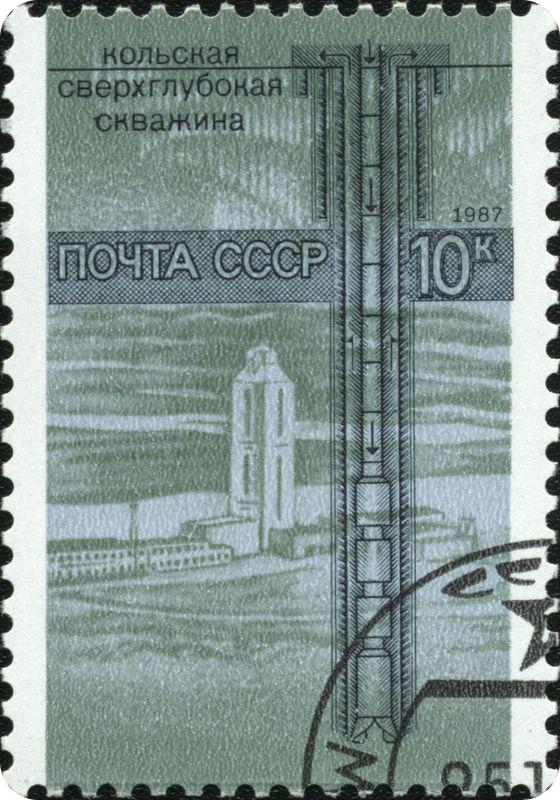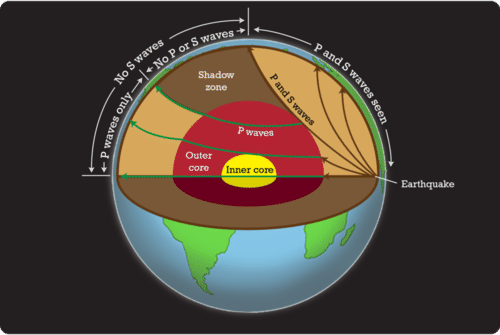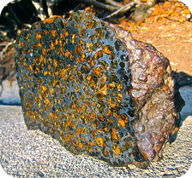3.12地球内部
章节大纲
-
How deep can we go into Earth's interior?
::我们怎样才能深入到地球的内部?Not very deep, that's for sure! The deepest a drill hole has gotten was the Kola Superdeep Borehole. That hole got to 12,262 meters (40,230 feet), about one-third of the way into the crust in that area. So learning about what's deeper requires less direct methods. A few of these methods will be described in this concept.
::孔洞最深处是科拉超级深孔洞。 这个洞长到12,262米(40,230英尺), 大约是进入那个区域地壳的三分之一。 所以了解更深处需要较少直接的方法。 其中一些方法将在这个概念中描述。Learning About Earth’s Interior
::学习地球内务If someone told you to figure out what is inside Earth, what would you do? How could you figure out what is inside our planet ? How do scientists figure it out?
::如果有人告诉你要弄清楚地球里面是什么,你会怎么做?你怎么知道我们星球里是什么?科学家怎么弄清楚?Seismic Waves
::地震波Geologists study waves to “see” Earth's interior. Waves of energy radiate out from an earthquake’s focus . These waves are called ( Figure ). Seismic waves go different speeds through different materials. They change speed when they go from one type of material to another. This causes them to bend. Some seismic waves do not travel through liquids or gases. They just stop. Scientists use information from seismic waves to understand what makes up the Earth’s interior.
::地质学家们研究“观察”地球内部的波浪。 能量波从地震的焦点向外辐射。 这些波浪被称为(图 ) 。 地震波通过不同的材料以不同的速度变化。 当它们从一种物质转向另一种物质时,它们会改变速度。 这使得它们弯曲。 一些地震波不会通过液体或气体流动。 它们只是停下来。 科学家们利用地震波的信息来了解地球内部的构成因素。The properties of seismic waves allow scientists to understand the composition of Earth's interior. Meteorites
::流星体Scientists study meteorites to learn about Earth’s interior. Meteorites formed in the early solar system . These objects represent early solar system materials ( Figure ). Some meteorites are made of iron and nickel. They are thought to be very similar to Earth's core . An iron meteorite is the closest thing to a sample of the core that scientists can hold in their hands!
::科学家们研究陨石来了解地球的内部。 在早期的太阳系中形成了陨石。 这些天体代表早期的太阳系材料(图 ) 。 一些陨石是由铁和镍组成的。 据认为它们与地球的岩芯非常相似。 铁陨石是科学家们手中最接近的岩芯样本 。This meteorite contains the mafic minerals olivine and pyroxene. It also contains metal flakes, similar to the material that separated into Earth’s core (metal) and mantle (ultramafic rock). Density
::密度Earth’s overall density is higher than the density of crustal , so the core must be made of something dense, like metal.
::地球总密度高于地壳密度, 所以核心必须由金属等密集物质组成。Magnetic Field
::磁场Since Earth has a magnetic field , there must be metal within the planet. Iron and nickel are both magnetic.
::由于地球有磁场,行星内必须有金属,铁和镍都是磁场。Summary
::摘要- Different types of seismic waves behave differently in different materials. Their behavior can tell scientists about the material they travel through.
::不同种类的地震波在不同材料中的表现不同。它们的行为可以让科学家知道它们经过的材料。
- Earth must contain metal. Its density, and the fact that it has a magnetic field, require it.
::地球必须含有金属。它的密度,以及它有磁场的事实,都要求它。
- Meteorites formed early in the solar system. They indicate something about Earth's interior.
::太阳系早期形成的气象,它们显示地球内部的一些东西
Review
::回顾- How do scientists know that Earth's interior contains metal?
::科学家怎么知道地球内部有金属?
- What do meteorites tell us about Earth's interior?
::陨石告诉我们地球的内部是什么?
- How do scientists use seismic waves to learn about Earth's interior?
::科学家如何利用地震波来了解地球的内部?
Explore More
::探索更多Use the resource below to answer the questions that follow.
::利用以下资源回答以下问题。- What types of waves do earthquakes produce?
::地震会产生何种波浪?
- What are the fastest body waves?
::什么是最快的身体波浪?
- What is the shadow zone?
::什么是影子地带?
- What do S-waves do?
::电波是做什么的?
- List and explain the two types of surface waves.
::列出并解释这两类表面波浪。
- Different types of seismic waves behave differently in different materials. Their behavior can tell scientists about the material they travel through.


